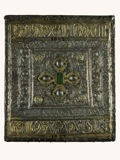Ink-pot
Inv. No. 1515
Silver
Unknown provenance
Octagonal ink-pot with conical cover, bronze chain and
crosses.
Two
cauldrons
Inv. No. 5019/2
Bronze
Asfoun, Upper Egypt
In the Roman era every-day objects were preferably made of
bronze. These two cauldrons are provided with two strap
handles. Three of its four feet are in the form of an
animal’s legs.
Bible
casket
Inv. No. 4867
Wood, silver
H: 39,5 cm, W: 29 cm, D: 10.5 cm
Unknown provenance, 1255
This precious Bible casket of wood is covered with embossed
silver sheets attached by nails. A rombic and floral
pattern runs along all four sides. In the centre Virgin
Mary with Jesus sitting on her lap are placed in between
two Arabic lines.
Bible
casket
Inv. No. 1565
Wood, silver with gilding, glass
H: 49 cm, W: 38 cm, D. 10 cm
Old Cairo, Church of the Virgin Mary (Qasrat al-Rihan),
1424
The entire surface of this richly decorated Bible casket is
embossed with floral patterns and interlace. In the centre,
cabochons of glass in white and green create a floral
pattern. A Coptic text at the upper and lower edges of the
casket designate the church the casket was dedicated to, in
A.D. 1424.
Eagle
Inv. No. 1510
Bronze
H: 47 cm, W: 41 cm
Old Cairo, Fortress of Babylon, 3rd / 4th century
A majestic eagle with outspread wings holds in its talons a
horn filled with leaves and fruitbearing branches. The
eagle is an ancient symbol of power, beauty and
independence. In Christianity the eagle became a symbol of
resurrection and the evangelist St. John. This bronze eagle
was discovered in the debris of the Fortress of Babylon.
Lamp
Inv. No. 1386
Bronze
Provenance unknown, Byzantine period
This lamp on an elaborate stand is decorated with a cross
implying a religious context. A rooster is placed at its
top.





